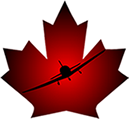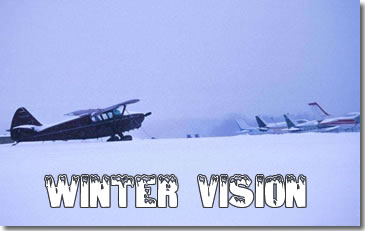 |
|
“The
machine does not isolate man from the great problems of nature --Antoine de Saint-Exupery--
Now, we mustn’t be too negative; there are several months during which it would be uncharitable to describe Canada as a cool, dark place. The winter months, however, even in the banana belt of Southern BC, can certainly include times when ambient light levels could be accurately described as low and other visual challenges become an important part of our flying lives. We have all heard again and again about the challenges involved with cold, ice or snow- covered runways, icing conditions, survival precautions and the difficulties of winter flying. Our visual environment, so critical to safe VFR flight, can also present some unique challenges during the winter season. Ambient light levels, the light available to our eyes, glare, reduced visibility due to weather and the various reflection and refraction illusions all affect our ability to see and respond to the world around us. Many private pilots do not choose to give up flying or put their aircraft in storage for the winter. Commercial pilots and our dedicated cadre of flight instructors fly all year long. For them, it is a good plan to be aware of the various difficulties that conditions can produce and make decisions based on full knowledge of the effects of those conditions. At all times it is important to know our personal limits and to stick by them. The ambient light level, the quantity of light available to our eyes, can have a significant effect on our ability to see. Human eyes have different sensitivity levels depending on available or ambient light level. A quick review of our secondary school biology will remind us that there are two types of light receptors in the eye: rods and cones. Cones are concentrated near the centre of the eye, the fovea; rods are concentrated around the periphery. Cones are the primary receptors for colour and visual acuity, recognition of detail; rods have no colour sensitivity, are poor at receiving specific detail, but are the primary receptors for the perception of motion. Under low light conditions, scotopic vision, rods provide the major source of visual information to the brain. Under bright light conditions, photopic vision, the cones predominate. Between scotopic illumination levels and photopic illumination levels is the mesopic range, or mid-level lighting conditions, where both cones and rods function well. In this light range, vision is both peripheral and central and colour begins to become clearly apparent. (1) For sharp vision, photopic vision levels of light are required and we must be looking directly at an object. In low light conditions, we cannot see an object as clearly looking directly at it. We must look a bit to the side to maximize our clarity. Averted vision is the best way to maximize the efficacy of the rods (2). According to Werner Adrian of the University of Waterloo, “With decreasing luminance levels, the spectral sensitivity of the eye changes…This goes in concert with the fading of colours until, in low levels, we perceive brightness only,” (3). As the light dims during a winter flight, it is an excellent idea to remember that our visual capabilities are changing as well. Direct vision is no longer as clear and precise as it would be in bright light conditions. We begin, as the light fades, to rely more and more on our peripheral vision and our sense of motion rather than our direct, detail vision. Our scanning techniques should reflect this new visual reality. Glare, resulting from direct or reflected light, can also be a significant factor during the winter months. Low sun angles tend to increase the amount of glare to which a pilot is exposed. The eye responds to glare physiologically by closing the retinal opening, decreasing the amount of light entering the eye. The normal, human response to painful glare is to either shade the eyes or to turn away from the glare source or both. Each of these natural and necessary responses to the sudden brightness of glare significantly reduces a pilot’s ability to see objects in proximity to the glare source. We have all experienced the difficulties involved in flying toward the sun when it is at a low angle or over flooded fields or snowy areas which strongly reflect the sun’s glare. Any scratches or dirt on the windscreen magnify the effects of glare and make vision even more difficult. Wearing a good pair of sunglasses and doing a proper job of cleaning the windscreen before each flight are highly recommended. It may sometimes be a very good plan to consider the sun’s position when plotting a navigational route. Just as a sailboat might tack or zigzag into the wind, the pilot of an aircraft might consider adapting his or her route to avoid flying directly toward the sun. Reduced visibility due to weather conditions needs little explanation, but it is an important phenomenon to keep in the front of our minds. Rain, snow, ice rime, mist, cloud and drizzle all reduce our ability to see clearly, decrease the distance we are able to see and reduce the ambient light level which also affects our vision as we discussed previously. In extreme snow or cloud conditions or when the ground is completely covered with snow and the sky is clouded, we may experience whiteout during which we lose our ability to differentiate between sky and ground. Our horizon will disappear. Our depth perception and distance judgement will be lost. We are no longer flying VFR but have entered Instrument Meteorological Conditions, IMC. Under whiteout conditions, immediate transition to instruments becomes mandatory. Landing in whiteout conditions or even conditions approaching whiteout will make judging approach height extremely difficult and will provide a visual environment similar to a glassy-water landing on floats without the benefit of a visible horizon. Rain and drizzle also produce some interesting illusions. As light passes from one medium to another—air to water and back—its bends or “refracts” and spreads apart or “diffuses.” Both of these phenomenon can have serious consequences if not properly understood and compensated for. All of us have, at one time or another, stuck our hand or a stick into water and seen the hand or stick “bend”. This phenomenon is called refraction. Light passing through the medium of water changes direction giving the illusion that the immersed object is bent. Refraction of light through the medium of water can result in our seeing objects outside at a different altitude than they would normally appear. The light arriving at our eyes has been bent en-route giving a false perception of our horizon. Tops of obstacles like hills and the horizon itself will appear lower than they actually are. The general rule of thumb is that objects half a mile ahead of our aircraft may appear to be as much as 200 feet lower than actual. Refraction can produce some very interesting illusions on landing and taking off as well. I always try to make a point of taking students up flying in the rain, at some point during their training, so they can see first hand that the illusions we have been talking about in ground school are both very true and, at first encounter, very confusing. Light passing through water, as well as being refracted, is diffused or spread apart. This results in two interesting effects: lighted objects in the distance will appear less bright because of the diffusion and apparent lowered intensity of the source and, therefore, will appear to be farther away than they actually are. Lighted objects, such as runway lights, because of the diffusion of their light, will appear to be larger than they actually are; our poor, little brains will be tempted to interpret this information to mean that the lights are closer than they actually are. Winter can provide some of the most beautiful flying of the entire year. Aircraft perform much better in the cold, dense air. When winter conditions are stable, summer’s thermal turbulence, which can be irritating at the best of times, is absent. Winter flying does, however, present a number of serious challenges to our skills and to our fund of knowledge. Just as we must develop the knowledge, skills and judgement to deal safely and effectively with phenomenon such as ice, hail, wind and slippery runways, so too it is important to know and understand, to have the knowledge, skills and judgement to deal with the unique visual effects of the winter season. End Notes 1.
Crawford, David, 1998, Some Issues in Low Light Level Vision, IDA Inc.,
Tucson, Arizona, pg. 1
|



